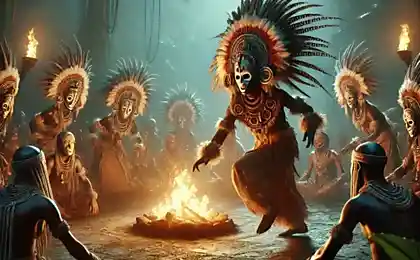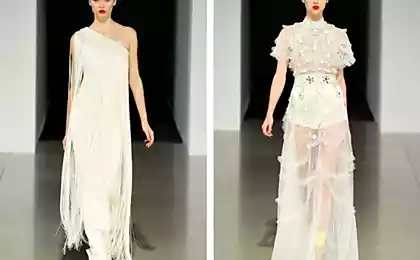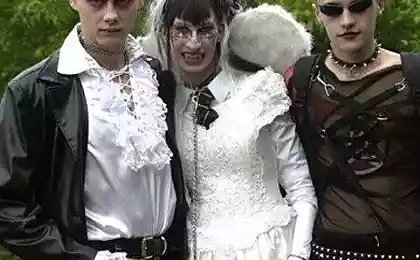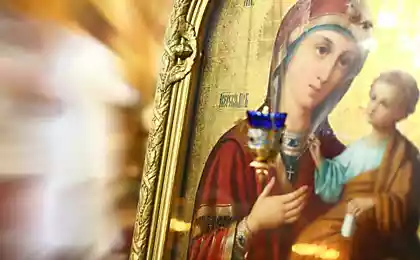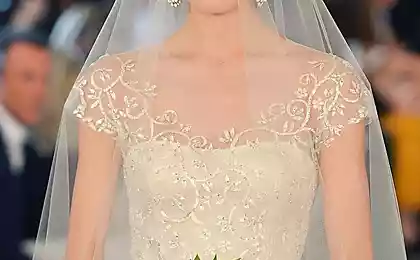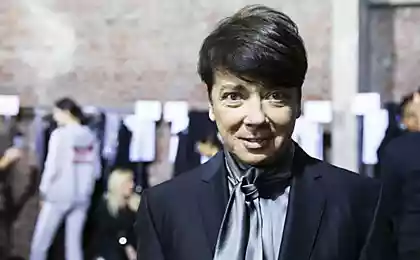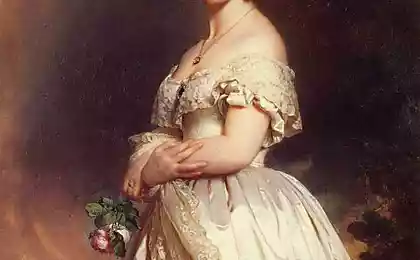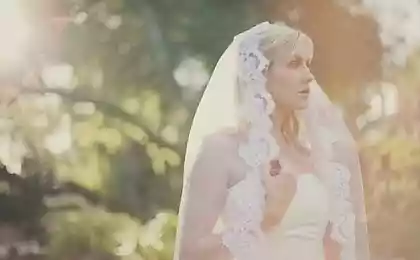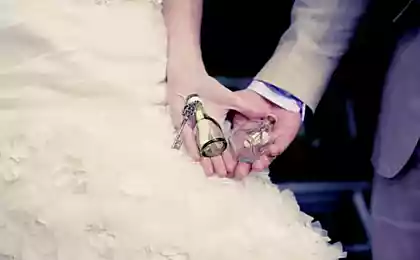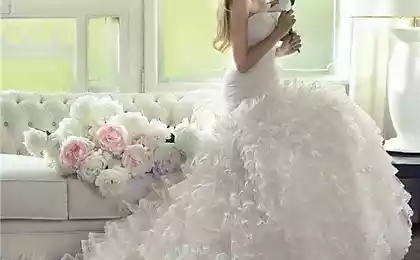788
Disappeared wedding ceremonies
It is hard to imagine that today the bride every morning since courtship until the day of her marriage left the house and wailed, wept, mourned his virginity, beauty, youth.
However, as hardly seem possible now many of the customs and rituals that were once an integral part of the wedding ritual, and now either forgotten, or lost, or reinterpreted ...
Courtship
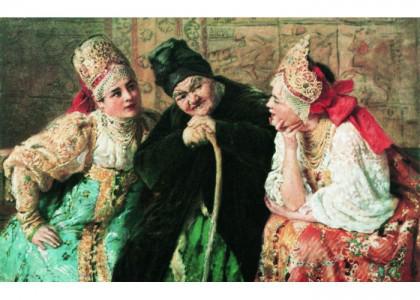
Matchmaking - is not only the unexpected arrival of the groom, accompanied by relatives of the bride's home to woo in allegorical form (to show themselves so see item). Courtship was that starting point, which literally started degeneration main participants in the wedding ceremony, the bride and groom. Since most prosvataniya on the bride (sgovorenku) imposes restrictions on movement, its living space narrows sharply to the limits of the family home. If a girl and leave, unless accompanied by friends and, in fact, only to invite guests to the wedding. The bride also declining to all household chores, becomes incapacitated. So there was a gradual "dehumanization" necessary for the birth of a new human family already.
Bride
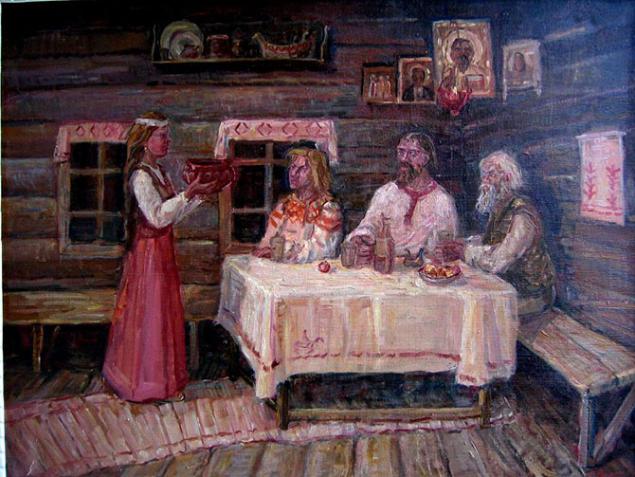
After two or three days after the courtship groom and his close relatives once again come to the bride's house, now the bride, during which the girl should show itself in all its glory and to demonstrate their skills and abilities in the same way as the bride who adorns the front all gathered. Then the mother of the groom closely examines and evaluates the bride's dowry. Everything that happens is necessarily accompanied by songs and lamentations - often by friends of the bride. However, she could refuse marriage, not coming to the groom.
Handshake
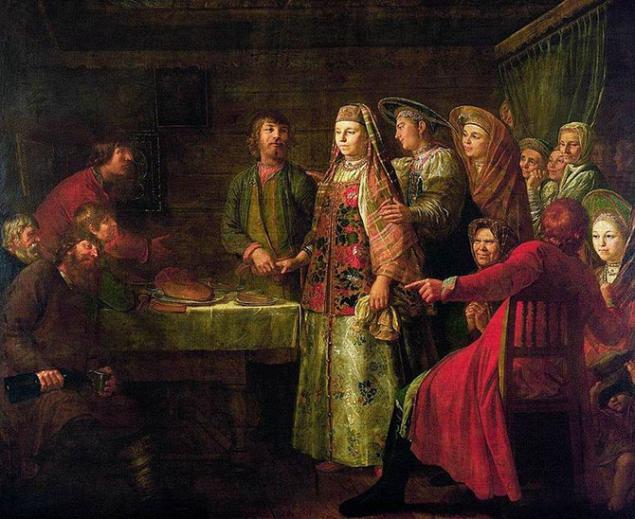
Shortly before the scheduled wedding day happened Handshake or booze, an event that eventually consolidated the arrangement of the wedding. After Handshake refusal of marriage was impossible. The bride and groom were seated next to a table and styled in the songs that were performed bridesmaids.
And what do the bride and groom themselves? The bride does not razgovorivaet and wails, and in some homes and did call vylnitsu that "howls," that is performed prichety and groom groans and cries. And, despite the apparent activity of the groom, his constant movement (he comes to the bride's house almost every day after Handshake on "pobyvashki", "kiss", "provedki"), yet he remains passive: for him say and do all the matchmakers, relatives and cronies.
Bachelorette party

Is this rite is also disappeared? The fact that a bachelorette party in Russia - this is not only the bride's farewell gatherings with friends on the eve of the wedding, but also the production of "Beauty" ("Will"), unwinding of braids, wash in the bath of the bride, destruction or transfer of "beauty" girlfriend or fiance. Maiden "beauty" - the last thing that binds the bride with her girlhood. It could be a tow, tree, decorated with ribbons and rags, garland, shawl. After manufacturing the "beauty" of her burning or bride handing her close friend. Whatever the subject, symbolizing the "beauty", he invariably associated with the head, fine hair, and the hair - a kind of personification of the girl's beauty will. With the destruction or distribution of "beauty" allegorically girl deprived of girlhood.
Also, the bride could cut the braid and pass it to the groom. A ritual bath in the bath finally completes the process: the bride became "neither alive nor dead," and in this state it passed the groom, the negotiations are, and the bride and her friends struggled resisted.
Hairstyles Moloduha
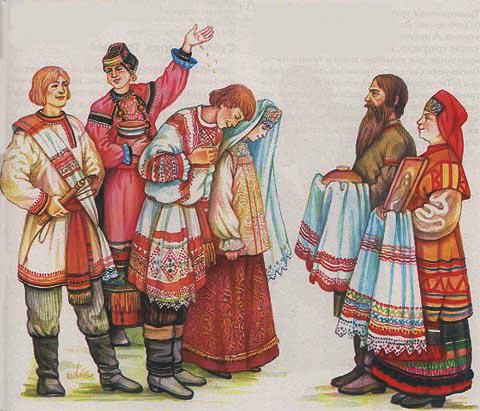
Immediately after the wedding the bride updo moloduhi: braided two braids and covered his head with a handkerchief or immediately "okruchivaet like a woman": two long plaits hair tightened at the back in a bun and put on top of the headdress of a married woman (Ochipok, ochtok, basting) . From this point on the bride's hair could only see her husband: Show bareheaded strange men was tantamount to treason, and tear off women headdress - an insult. The change means changing hairstyles girls to the power of her husband, as well as the formation of a new image of the man, his rebirth in the new status. The girl begins to "come to life": returns to it's ability to move independently, as well as the ability to do everything with your hands: the bride entering the house, begins to actively develop its space throws rye, puts korovay throws belt and others.
"Uncovering BRIDE»
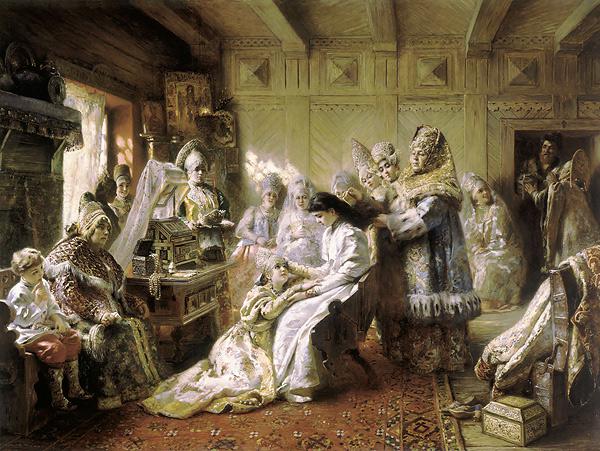
Special rite was dedicated to "inflatability" bride when young came from the wedding the groom's house. This ceremony was endowed with a double meaning: it meant for the bride of the return; bride, continuing to revive, now looked at all other eyes, and for the bride it was kind of getting to know your favorite, as it was now different. Some details of the rite be read erg matic sense when the bride "reveal": father in law or boyfriend lifts the hem of her whip, tongs, cake or stick. Or put on the bride's head cake without filling, symbolizing a child, and wrapped it in a handkerchief, put it in a closet, where young separately from all ate first, and then carried on their wedding night. In some areas, it was the custom to hold a bed newlyweds in the cage or barn, which is associated with the idea of fertility and childbirth.
"OTVODINY»
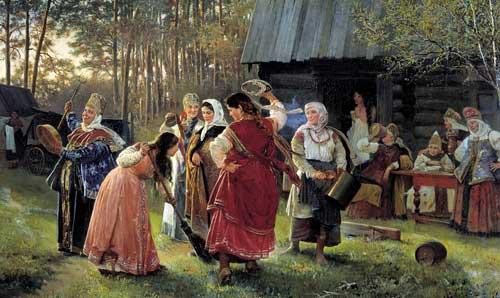
"Otvodiny" (a joint visit to the young bride's parents) marks the end of the wedding as a special status for all participants. This element of the wedding ceremony is particularly important for the bride who comes for a short time and as a guest, which underlines the irreversibility of all the transformations that have occurred to her during the wedding. However, there are also other data on the relationship with the bride's home. For example, in the province of Voronezh, the young women during the first year of marriage lived with his mother and was engaged in spinning for their future needs.
However, as hardly seem possible now many of the customs and rituals that were once an integral part of the wedding ritual, and now either forgotten, or lost, or reinterpreted ...
Courtship

Matchmaking - is not only the unexpected arrival of the groom, accompanied by relatives of the bride's home to woo in allegorical form (to show themselves so see item). Courtship was that starting point, which literally started degeneration main participants in the wedding ceremony, the bride and groom. Since most prosvataniya on the bride (sgovorenku) imposes restrictions on movement, its living space narrows sharply to the limits of the family home. If a girl and leave, unless accompanied by friends and, in fact, only to invite guests to the wedding. The bride also declining to all household chores, becomes incapacitated. So there was a gradual "dehumanization" necessary for the birth of a new human family already.
Bride

After two or three days after the courtship groom and his close relatives once again come to the bride's house, now the bride, during which the girl should show itself in all its glory and to demonstrate their skills and abilities in the same way as the bride who adorns the front all gathered. Then the mother of the groom closely examines and evaluates the bride's dowry. Everything that happens is necessarily accompanied by songs and lamentations - often by friends of the bride. However, she could refuse marriage, not coming to the groom.
Handshake

Shortly before the scheduled wedding day happened Handshake or booze, an event that eventually consolidated the arrangement of the wedding. After Handshake refusal of marriage was impossible. The bride and groom were seated next to a table and styled in the songs that were performed bridesmaids.
And what do the bride and groom themselves? The bride does not razgovorivaet and wails, and in some homes and did call vylnitsu that "howls," that is performed prichety and groom groans and cries. And, despite the apparent activity of the groom, his constant movement (he comes to the bride's house almost every day after Handshake on "pobyvashki", "kiss", "provedki"), yet he remains passive: for him say and do all the matchmakers, relatives and cronies.
Bachelorette party

Is this rite is also disappeared? The fact that a bachelorette party in Russia - this is not only the bride's farewell gatherings with friends on the eve of the wedding, but also the production of "Beauty" ("Will"), unwinding of braids, wash in the bath of the bride, destruction or transfer of "beauty" girlfriend or fiance. Maiden "beauty" - the last thing that binds the bride with her girlhood. It could be a tow, tree, decorated with ribbons and rags, garland, shawl. After manufacturing the "beauty" of her burning or bride handing her close friend. Whatever the subject, symbolizing the "beauty", he invariably associated with the head, fine hair, and the hair - a kind of personification of the girl's beauty will. With the destruction or distribution of "beauty" allegorically girl deprived of girlhood.
Also, the bride could cut the braid and pass it to the groom. A ritual bath in the bath finally completes the process: the bride became "neither alive nor dead," and in this state it passed the groom, the negotiations are, and the bride and her friends struggled resisted.
Hairstyles Moloduha

Immediately after the wedding the bride updo moloduhi: braided two braids and covered his head with a handkerchief or immediately "okruchivaet like a woman": two long plaits hair tightened at the back in a bun and put on top of the headdress of a married woman (Ochipok, ochtok, basting) . From this point on the bride's hair could only see her husband: Show bareheaded strange men was tantamount to treason, and tear off women headdress - an insult. The change means changing hairstyles girls to the power of her husband, as well as the formation of a new image of the man, his rebirth in the new status. The girl begins to "come to life": returns to it's ability to move independently, as well as the ability to do everything with your hands: the bride entering the house, begins to actively develop its space throws rye, puts korovay throws belt and others.
"Uncovering BRIDE»

Special rite was dedicated to "inflatability" bride when young came from the wedding the groom's house. This ceremony was endowed with a double meaning: it meant for the bride of the return; bride, continuing to revive, now looked at all other eyes, and for the bride it was kind of getting to know your favorite, as it was now different. Some details of the rite be read erg matic sense when the bride "reveal": father in law or boyfriend lifts the hem of her whip, tongs, cake or stick. Or put on the bride's head cake without filling, symbolizing a child, and wrapped it in a handkerchief, put it in a closet, where young separately from all ate first, and then carried on their wedding night. In some areas, it was the custom to hold a bed newlyweds in the cage or barn, which is associated with the idea of fertility and childbirth.
"OTVODINY»

"Otvodiny" (a joint visit to the young bride's parents) marks the end of the wedding as a special status for all participants. This element of the wedding ceremony is particularly important for the bride who comes for a short time and as a guest, which underlines the irreversibility of all the transformations that have occurred to her during the wedding. However, there are also other data on the relationship with the bride's home. For example, in the province of Voronezh, the young women during the first year of marriage lived with his mother and was engaged in spinning for their future needs.

